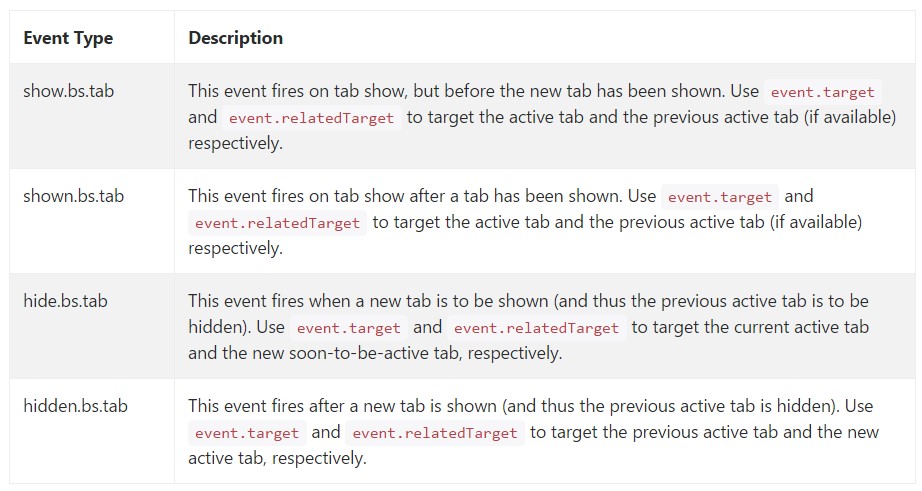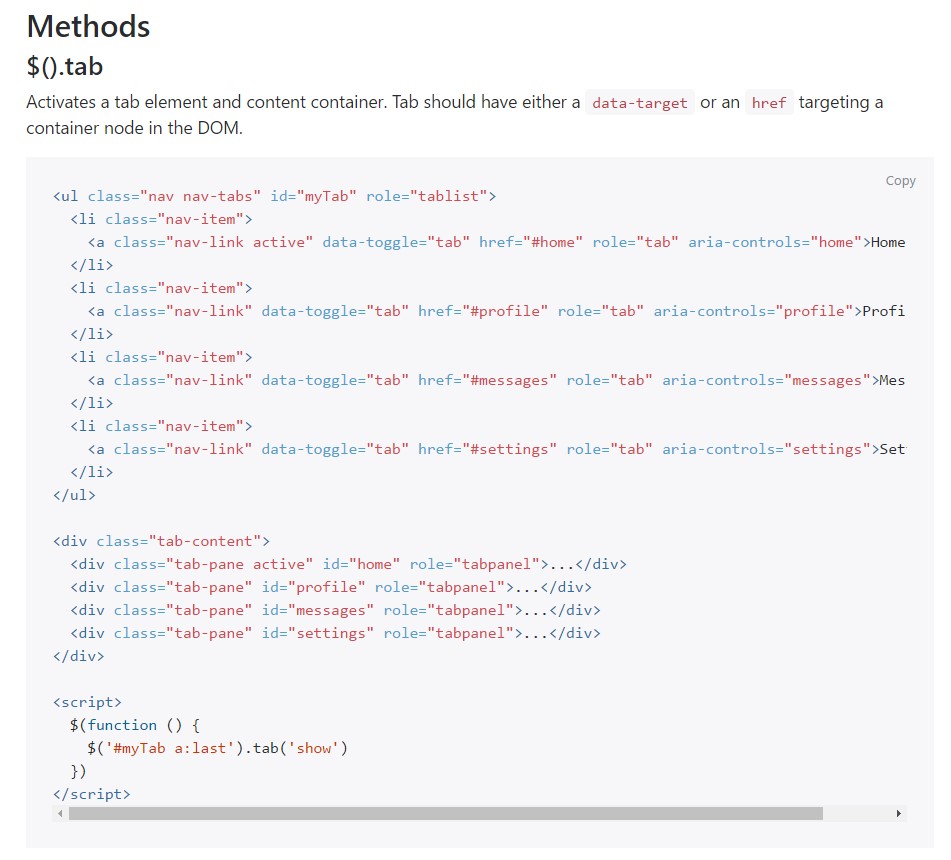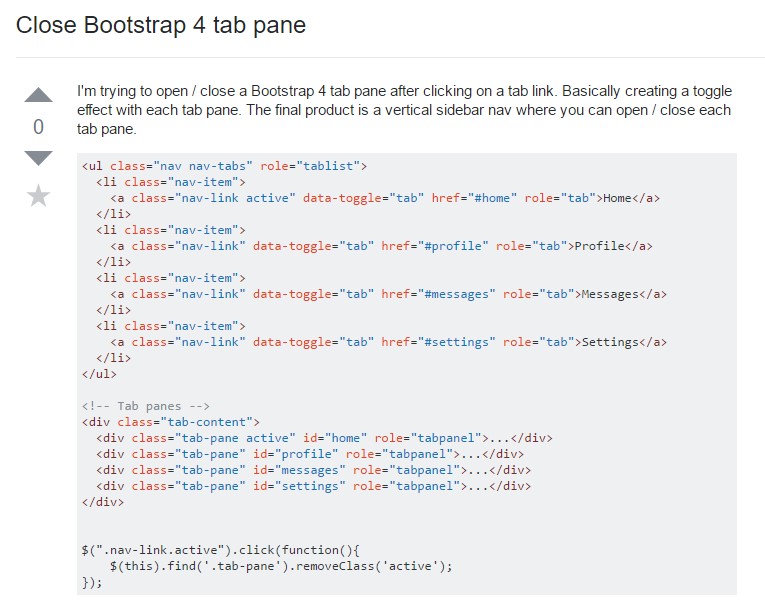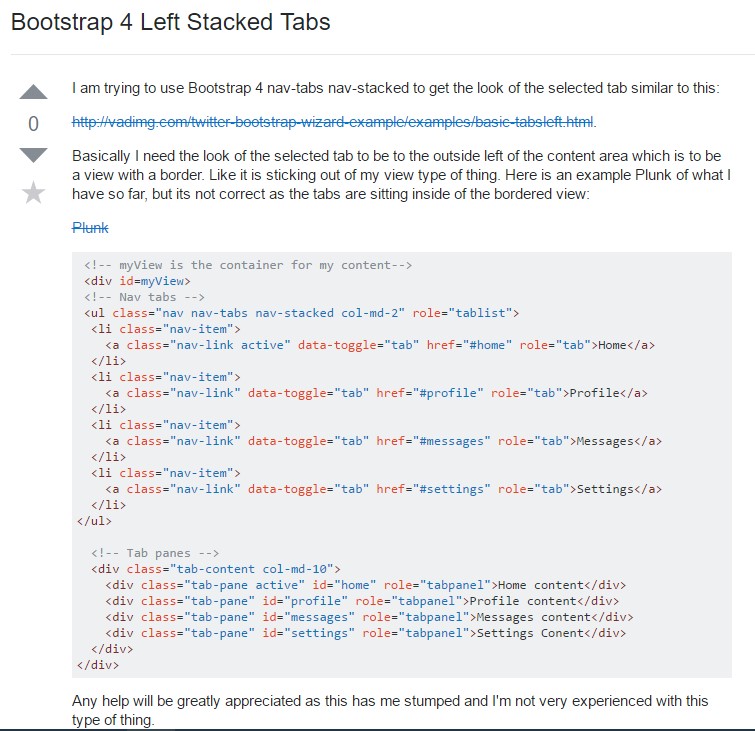Bootstrap Tabs Styles
Introduction
In some cases it is really pretty helpful if we can simply place a few segments of details sharing the very same place on page so the visitor simply could search through them without any really leaving the display. This gets quite easily achieved in the brand new fourth version of the Bootstrap framework by using the .nav and .tab- * classes. With them you might conveniently build a tabbed panel with a several forms of the content maintained inside every tab enabling the visitor to simply click on the tab and come to check out the wanted web content. Let us have a deeper look and check out how it is actually done.
How to employ the Bootstrap Tabs Using:
To start with for our tabbed control panel we'll need to have some tabs. To get one make an <ul> element, designate it the .nav and .nav-tabs classes and put several <li> elements inside holding the .nav-item class. Within these kinds of selection the real hyperlink elements should accompany the .nav-link class designated to them. One of the links-- normally the first really should additionally have the class .active because it will definitely work with the tab being presently exposed when the webpage gets loaded. The web links in addition need to be appointed the data-toggle = “tab” attribute and every one really should aim at the suitable tab panel you would want to get showcased with its own ID-- as an example href = “#MyPanel-ID”
What is certainly brand new in the Bootstrap 4 framework are the .nav-item and .nav-link classes. In addition in the earlier edition the .active class was designated to the <li> component while now it get delegated to the web link itself.
Now when the Bootstrap Tabs Border system has been simply prepared it is simply time for building the panels having the actual material to get featured. 1st we want a master wrapper <div> element together with the .tab-content class specified to it. Within this particular feature a few elements holding the .tab-pane class ought to take place. It also is a pretty good idea to include the class .fade in order to guarantee fluent transition whenever swapping between the Bootstrap Tabs Set. The feature that will be featured by on a webpage load must additionally hold the .active class and in the event you go for the fading shift - .in along with the .fade class. Every .tab-panel should have a unique ID attribute which in turn will be applied for linking the tab links to it-- just like id = ”#MyPanel-ID” to fit the example link coming from above.
You can likewise develop tabbed sections employing a button-- just like appearance for the tabs themselves. These are additionally referred like pills. To perform it simply just make sure as opposed to .nav-tabs you designate the .nav-pills class to the .nav feature and the .nav-link hyperlinks have data-toggle = “pill” in place of data-toggle = “tab” attribute.
Nav-tabs methods
$().tab
Activates a tab feature and web content container. Tab should have either a data-target or an href targeting a container node in the DOM.
<ul class="nav nav-tabs" id="myTab" role="tablist">
<li class="nav-item">
<a class="nav-link active" data-toggle="tab" href="#home" role="tab" aria-controls="home">Home</a>
</li>
<li class="nav-item">
<a class="nav-link" data-toggle="tab" href="#profile" role="tab" aria-controls="profile">Profile</a>
</li>
<li class="nav-item">
<a class="nav-link" data-toggle="tab" href="#messages" role="tab" aria-controls="messages">Messages</a>
</li>
<li class="nav-item">
<a class="nav-link" data-toggle="tab" href="#settings" role="tab" aria-controls="settings">Settings</a>
</li>
</ul>
<div class="tab-content">
<div class="tab-pane active" id="home" role="tabpanel">...</div>
<div class="tab-pane" id="profile" role="tabpanel">...</div>
<div class="tab-pane" id="messages" role="tabpanel">...</div>
<div class="tab-pane" id="settings" role="tabpanel">...</div>
</div>
<script>
$(function ()
$('#myTab a:last').tab('show')
)
</script>.tab(‘show’)
Picks the delivered tab and gives its own connected pane. Any other tab which was earlier chosen comes to be unselected and its associated pane is covered. Turns to the caller before the tab pane has really been displayed ( id est right before the shown.bs.tab occasion occurs).
$('#someTab').tab('show')Events
When displaying a brand new tab, the events fire in the following ordination:
1. hide.bs.tab ( on the present active tab).
2. show.bs.tab ( on the to-be-shown tab).
3. hidden.bs.tab ( on the prior active tab, the identical one when it comes to the hide.bs.tab event).
4. shown.bs.tab ( on the newly-active just-shown tab, the exact same one when it comes to the show.bs.tab event).
Assuming that no tab was already active, then the hide.bs.tab and hidden.bs.tab activities will not be fired.

$('a[data-toggle="tab"]').on('shown.bs.tab', function (e)
e.target // newly activated tab
e.relatedTarget // previous active tab
)Conclusions
Well primarily that is actually the manner the tabbed sections get made by using the newest Bootstrap 4 edition. A thing to pay attention for when making them is that the other elements wrapped within each and every tab section should be practically the same size. This are going to assist you stay away from some "jumpy" activity of your page when it has been already scrolled to a certain placement, the website visitor has begun browsing through the tabs and at a specific moment comes to open a tab with significantly more content then the one being certainly seen right prior to it.
Check a couple of online video tutorials regarding Bootstrap tabs:
Related topics:
Bootstrap Nav-tabs: authoritative documentation

How you can turn off Bootstrap 4 tab pane

Bootstrap 4 Left Stacked Tabs
